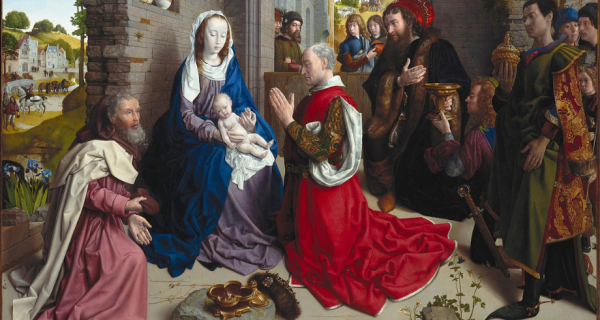Two figures embody Advent: one, obvious by his irrepressible presence, the other hidden in her quiet faith. Taken together, they instruct us not only in the true meaning of Advent, but in the real meaning of our lives.
St John Baptist embodies the prophets of the Old Testament: his birth echoes those of Isaac, Jacob and Samuel the Prophet; his harsh, desert life followed the pattern of the fiery Elijah, down to his clothes and crickety diet; John’s fierce denunciations of sin and corruption recall the grim warnings of Ezekiel and Jeremiah; and, like Isaiah, he died on the orders of an evil king. But most of all, he is of their number because St John summed up in himself message of the Old Testament: he pointed to Christ, the Savior Who was coming.
Another, however, embodies the promises of the New Testament: one who doesn’t point towards the Coming One, but who actually brings Him into the world: the maid of Nazareth, the Virgin who all generations call blessed, the Mother who carried God in her body, whose soul was pierced at the foot of the Cross, the Woman of the Apocalypse, wrapped in the brightness of the sun, standing on the moon, crowned with the twelve stars of the Testaments. As we come to the final days of Advent (called anciently in the Christian East “the Fore-feast of the Nativity”), St Mary the Virgin, like her cousin St John Baptist, points us to her Son, not hidden in the words of ancient prophecy, but waiting in her pregnant womb.
Before we sing our Eucharistic “Holy, Holy, Holy,” this Sunday, Bishop Ng’anga will read the Proper Preface we use the final Sunday of Advent, written in Milan 1500 years ago, which sums up the hopes of our fallen race in this season and in our lives. It joins the sober truths of the Old Testament with the grace-filled promises of the New:
“Because Christ, the One foretold by the ancient Prophets; the One carried in the womb of His Virgin Mother; the One proclaimed by John and brought forth by Mary, the One Who fulfills the desire of the Patriarchs and Prophets, the Priests and Kings of old, and of all our race since Father Adam and Mother Eve, He Whom all have longed for is now coming among us.”
The Baptist and the Virgin aren’t cardboard characters. Consider their tales: the Baptist leaping with joy while still in his mother’s womb at the presence of Christ, still in 𝙃𝙞𝙨 Mother’s womb; walking the Judean desert, hermit-like, searching for God in the scorching wilderness; snarling threats at the self-righteous Pharisees while gently immersing in the cool waters of the Jordan those who sought God in penitence; scorning the executioner’s axe in his attempt to drive the adulterous Herod to repentance. Was there ever a man who so plainly showed what it means to be a man?
When God sent the Archangel Gabriel to Nazareth, it wasn’t in hopes of finding a virgin who was willing to go along with the plan that “a virgin shall conceive.” The Gospel the deacon will read Sunday morning is plain: “…the angel Gabriel was sent 𝗳𝗿𝗼𝗺 God 𝘁𝗼 a city of Galilee named Nazareth, 𝘁𝗼 a virgin espoused to a man whose name was Joseph, of the house of David; 𝗮𝗻𝗱 𝘁𝗵𝗲 𝘃𝗶𝗿𝗴𝗶𝗻‘𝘀 𝗻𝗮𝗺𝗲 𝘄𝗮𝘀 𝗠𝗮𝗿𝘆.” The Lord didn’t choose Mary that morning. With God there are no mornings: what we perceive as past, present and future are all one with Him. Before Mother Eve dropped the apple on the ground in Paradise, God chose Mary to be the New Eve, Mother of His Messiah and Mother of His Church. What God created women to be, which Eve had flubbed in the Garden, came to life in Mary.
If our Advent is to come to fruition, to be more than shopping days till Christmas, if our lives are to grow into the fulness of Christ as men and women, children of God, look to St John the Baptist and St Mary the Theotokos. We’ll see something of what God means us to be.

